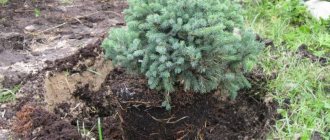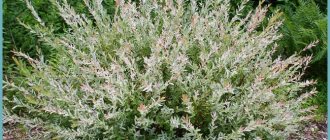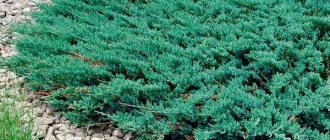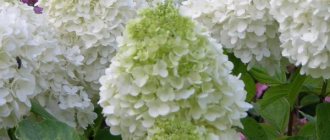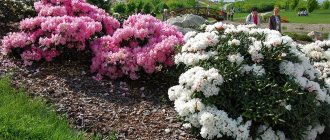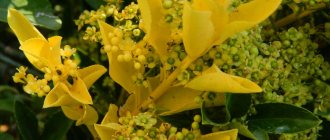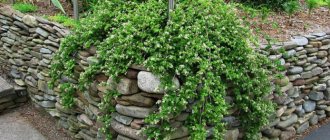Deutzia is an Asian plant that recently began to appear in Russian garden plots and well-groomed park areas. During the flowering period, this “child of the east” becomes a lush, noticeable and very decorative shrub that looks great solo on a green lawn, in company with conifers, and in landscape compositions with a characteristic Asian accent. Planting deutia bushes and caring for them in the open ground is quite troublesome, but no less enjoyable, since this oriental beauty knows how to respond with gratitude to care.
Description and photo of the bush
Deutzia is a perennial deciduous shrub of medium size (about 1 m on average) from the Hydrangeaceae family. The stem shoots have a characteristic feature common to many crops of this family - peeling of the bark. Despite the fact that this makes the bush look strange and untidy, this is a normal natural phenomenon. In addition, when the deutia blooms, its shoots are reliably hidden from view by the lush flowering crown. In the second year of life, they become hollow inside and, as a result, brittle. This feature must be taken into account when organizing shelter in winter. The leaves are entire, without dissections, with serrated edges, and have an opposite arrangement.
The medium-sized shrub blooms with inflorescences formed at the ends of last year's branches. The flowers are often painted in pastel colors - white, cream, carmine, pink, lilac or purple, and have a simple or double shape. For gardeners, the plant is attractive for its long flowering, which begins literally immediately after the lilac fades and can last up to 2 months.
If in the garden, in addition to deutzia, you plant shrubs of lilac, roses and mock orange, then the flowering of this group will be almost continuous throughout the season.
Why trim the action?
Pruning flowering shrubs of any type is aimed at creating abundant flowering and creating a beautiful crown. Competent rejuvenating pruning of deutia in the fall often helps to save dying bushes.
The following types of vegetative cleansing are used for action:
- Annual sanitary. Task: cut out frozen, old, diseased and crooked branches that can become a source of disease.
- Summer, after flowering. Objective: to lighten the bush and stimulate good aeration.
- Ultimate formative. Task: leave last year's shoots and remove current year's shoots, at the same time giving the bush the desired shape.
- Rejuvenating as the bush ages. Task: to form a new crown from young strong shoots from the mother stump.
Planting and care
Deutzia is a plant for open ground with its own specific agricultural technology, but if everything is done correctly, you can be guaranteed an excellent result.
Choice of location, soil
Important factors in choosing a site for planting are the absence of high groundwater and strong winds. The soil should be loose, permeable, cultivated to a depth of at least half a meter, with a neutral or slightly acidic pH. If a planting site has already been chosen, and the quality of its soil leaves much to be desired, it can be replaced with a volume approximately 40 cm larger than the planting hole in all directions based on an adult bush. It is advisable to include turf soil, sand and humus in the composition (half the amount of sand as the other ingredients).
Planting action
Shrubs should be planted in the spring. If seedlings are purchased before suitable weather has established, they should be stored in a room with low positive temperatures (0...+2C). The dimensions of the planting pit are 50 by 60 cm (remember that when replacing soil, the volume increases by 40-50%). A drainage layer of up to 15 cm made of broken brick or other coarse material is desirable.
If a seedling is purchased with bare roots without a container, before planting it is necessary to carry out an inspection, remove broken, frozen and diseased roots and shoots and place it in a solution with any biostimulator of root formation from several hours to a day. Containerized specimens with closed roots can be planted by transfer, but practice shows that the best solution is to remove them with a complete revision of the root system. If the roots are very tangled, they should be unraveled if possible and leveled over the planting hole, and only then watered with a solution mixed with a biogrowth stimulator. A distance of at least one and a half meters is left between neighboring seedlings.
To make the bush feel more comfortable, you can add a glass of slaked lime and/or a small amount of ash to the planting hole.
Watering
In adulthood, the deutzia shrub is drought-resistant, and any waterlogging is perceived by it as a negative external influence. The watering rate is a bucket of water for each bush with a watering frequency of once a week, but in practice the plant consumes even less moisture. A good substitute for watering is loosening to a depth of about 20 cm. In the hot and dry season, and also during flowering, this rate can be increased, but with the arrival of autumn, the plant is gradually stopped watering to give it the opportunity to activate its forces on the eve of winter. Young seedlings need a more flexible moisture system.
Top dressing
The first portion of fertilizers for deutzia is applied at the stage of preparing the site for planting. Add organic matter (compost or well-fermented liquid mullein) directly into the planting hole. You can mix ash with manure, but be sure to ensure that organic fertilizers are completely rotted. It is enough to add mineral complexes twice a season. As usual, this is the period of the beginning of budding and the middle of summer.
It is not advisable to apply fertilizers in the spring, since this invariably negatively affects the wintering of the plant.
Planting: where, when and how to plant action
Deutia is a light-loving shrub, but does not tolerate direct sunlight and drafts, so it is better to plant it in the partial shade of the crowns of large trees and in a place protected from the wind. Also, the bushes need space, which means that there should be no nearby tree or building at a distance of about 2 m around it.
For good growth and development of shrubs, soil that meets certain requirements is needed, namely:
- nutritious;
- slightly moisturized;
- with a slightly alkaline reaction;
- well drained;
- loose.
A good place for the action will be an area in the shade of a house.
If the soil on the site does not meet the requirements, then when planting you should fill the hole with the following composition: humus, sand, peat compost, taken in the proportion: 2: 2: 1. If the soil on the site is acidic, before planting you need to add slaked lime, approximately 300-350 g, into the hole.
It is best to plant deutia in the spring, since over the summer it will take root well and get stronger before the winter cold. The landing time in the Moscow region must be chosen according to the weather. The soil should have thawed by now, but the buds on the trees have not yet bloomed. Seedlings with closed roots (in containers with soil) can be planted until the beginning of June.
Advice! For better growth and development of the bush, it is advisable to shorten each shoot of the seedling to 4-5 buds after planting.
Now the main thing: how to plant shrubs correctly:
Mulching the soil around the bush
- Dig a hole approximately 50 cm deep.
- Place a layer of drainage on the bottom - fine crushed stone, sand, broken brick.
- Lightly sprinkle the drainage with the soil mixture described above, after adding 100 g of nitrophoska to it.
- Lower the roots of the seedling into the hole so that its root collar is at the level of the soil surface, or 1-2 cm underground.
- Cover the seedling with soil (or soil mixture), compact the soil and water it.
- Mulch the area around the seedling with a 4-5 cm layer of peat.
Advice! This fit is ideal, but again, optional. If the soil meets the requirements, then points 1,2,3 can be omitted. And, having dug a hole, immediately proceed to step 4.
Pruning action in the fall
Despite the well-established opinion that shrubs should be formed in the fall, pruning of deutia is recommended in the spring or at the very beginning of the summer. In the spring, all poorly overwintered, frozen and broken branches are exposed, and all shoots growing inside the crown must be pruned. It should be produced to the level of a healthy young shoot. In addition, it is recommended to do formative and rejuvenating pruning, removing last year's shoots by half, a third, or at least a quarter. This perfectly stimulates the formation of flower buds for next year. In adult specimens older than 5 years, it is recommended to cut out 2-3 of the oldest shoots to the very base every 3 years, thereby stimulating the shrub to produce young growth.
Action care
This ornamental crop, although it is considered drought-resistant and unpretentious, shows its full beauty only when all agrotechnical measures are carried out (feeding, weeding, watering, pruning).
Watering
In hot and dry months, you need to water the deutia 2 to 3 times every four weeks, and when it rains, watering is carried out only when the top layer of soil dries out.
15-20 liters of water are poured under each bush.
After heavy watering or rainfall, it is advisable to loosen the surface of the soil around the bushes to remove the dense crust. Deep loosening is not carried out so as not to damage the roots.
Top dressing
This shrub is fed 3 times per season. In this case, fertilizing is carried out for the first time in the form of mulching the tree trunk circle with humus (half a bucket per plant).
The second time, liquid fertilizers based on mineral fertilizers with microelements are used. These feedings are carried out until the end of flowering.
The third (last) fertilizing is carried out before pruning. For it, use a solution of mullein, diluted one to ten. One bucket is used per plant.
Trimming
One of the main measures for caring for deytsia is timely and correct pruning.
In May-June, shoots that have frozen over the winter are removed from the bushes.
Every year after the end of flowering, rejuvenating and formative pruning is carried out.
Spectacular flowers are formed on perennial shoots, but the largest number of them bloom on 2-3 year old branches. When pruning, adult trunks that are more than 4-5 years old are cut into a ring or a small stump about 15 cm high is left. Dry and poorly developed shoots need to be removed.
It is also necessary to shorten young elongated shoots so that the crown of the bush maintains a compact shape.
Preparing for winter
In order for the deutia wood to ripen well by the beginning of the cold weather, it stops watering in August. And with the onset of September, it is advisable to protect the bases of the bushes from heavy and prolonged rainfall using waterproof material.
Warming plants for the winter is carried out in two stages. The bushes are covered for the first time immediately after the onset of night frosts. At this time, the branches of the deutsium are pressed to the ground and secured, and then sprinkled with fallen dry leaves.
The branches of tall bushes break when bent, so such plants are covered with burlap or special non-woven material.
The second (additional) shelter is carried out when the average daily temperature falls below zero. Branches of spruce branches are placed at the base of the bushes, which helps to retain snow and thereby protects from freezing.
This coniferous shelter is removed after the snow has completely melted and warmth has established itself (avoiding overheating). Then the bush is freed from the remaining leaves.
Wintering action
The plant does not survive harsh winters as problem-free as many Russian perennials. Its shoots remaining on the surface can freeze heavily right up to the very level of the snow cover, however, in the spring they can begin to grow back from this very place. Alas, this is fraught with the fact that during this season the deutzia will no longer bloom, since it is primarily the young shoots that are affected by the cold, on which flower buds are laid next year. Therefore, caring for the plant in the fall requires a special approach.
The deutia bush can be covered, but the idea is complicated by the fragility of the hollow branches of the second year. Young bushes are carefully bent to the ground and arcs or poles are placed over them crosswise, on which spruce branches, foliage and other insulating materials are placed on top. The design will protect the plant from the load of the shelter and the snow covering it and from the cold.
It will not be possible to tilt an old bush this way due to the fragility of the branches - it will immediately break, so a different tactic is used here. Deutia's own foliage is considered as protection against frost, so they begin to cover it even before the leaves fall. The shoots are very carefully tied together with a wide rope (you can use scraps of old bed linen) and a bag sewn from any covering non-woven material (optimal density 60) is placed on the bush. The structure is fixed with ordinary clothespins. Under such cover, flower buds are also better preserved, since in this crop they are prone to drying out.
A frozen deutia bush is usually easily restored, but for successful flowering you will have to wait another year.
The most popular types of action for the middle zone
Deytsia Amur (small-flowered)
In its natural environment, this shrub grows in the Far East, China and North Korea. Habitats: oak and coniferous-deciduous forests. In Russia, Deutzia Amur is protected in the Far Eastern nature reserves. Deytsia Amur is a spreading shrub reaching 2 m in height.
Deytsia Amur
The bark on young shoots is brown, but becomes gray over the years. It has elliptical, finely serrated leaves, drooping and pointed at the ends, the length of which is 5-6 cm. In spring and summer, the color of the leaves is bright or grayish-green, and in autumn it changes to brown-yellow. The shrub sheds its leaves in winter.
The flowers are medium-sized white, collected in corymbose inflorescences with a diameter of 6-7 cm. The bush blooms in 2-3 years of life and the beautiful inflorescences, generously strewn with branches, delight the eye for almost 2 months: from May to early June. By autumn, the flowers ripen into fruits - spherical dark yellow boxes with small seeds.
Deytsia graceful (slender)
The most spectacular of the plant species introduced into cultivation. It is a round-shaped bush, up to one and a half meters in height. The branches are decorated with light green oblong lanceolate leaves, covered with sparse hairs on top. By autumn the leaves turn beautifully yellow, and by winter they fall off.
Deytsia graceful
Deutzia graceful blooms very beautifully. Since the end of May, its branches are literally covered with multi-flowered snow-white erect paniculate inflorescences, the length of which is 10 cm. This species can withstand the winter quite well, but it must be covered, and the best shelter for it will be a snow blanket.
Deutzia Lemoine
This is an excellent winter-hardy hybrid of Deutia Amur and Deutia graceana. It is a bush up to 2 m in height. Blooms early and abundantly. Bushes with paniculate inflorescences 9-10 cm long, collected from numerous white small (up to 2 cm) flowers, look very impressive and rich.
Deutzia Lemoine
Deutzia purpurea
A shrub 0.6-2 m high with thin broad-lanceolate green leaves up to 5 cm long, very beautiful during flowering - from early June to July.
Flowers, up to 2 cm in diameter, come in all shades of pink and purple, 6-12 pieces are collected in inflorescence-baskets.
Deutzia purpurea
Deytsia purpurea is a very spectacular and picturesque shrub, and although in the conditions of the Moscow region it is poorly adapted to the frosty winter and to preserve it you need to tinker with sheltering it from the cold, it is worth it - next year it will thank you for your care and again give beautiful flowers.
Reproduction
You can get new specimens of this decorative garden crop in almost all known ways.
Seeds
Usually the seeds are immediately planted in open ground, since the plant is a perennial and there is no particular hurry to plant deutzia. For this purpose, a training bed is made with nutritious and permeable soil of good looseness. It is better if it is located in partial shade. You can also use the seedling method, in which case the seeds are scattered over the surface without being buried, but you must ensure that they fit tightly to the ground and are permanently moistened. Drying of seed material and topsoil is not allowed. Sprouts should appear after 3 weeks, after which you need to wait for the second pair of true leaves and pick. When growing seedlings at home, picking should be done immediately into open ground. You can wait for the first flowering of deutia with the seed propagation method in the third year.
Cuttings
The method of planting by cuttings, as usual, is faster and more convenient. For this you can use both green and lignified cuttings. The first ones are cut from mid-June to mid-July (the first ten days), choosing young shoots of the current year that have not yet had time to become lignified (covered with dark bark). The lower oblique cut is treated with a biostimulator and buried in an inclined position to a depth of about 5 cm.
For rooting, it is advisable to use a greenhouse or an artificial mini-greenhouse, which can be easily made by covering the container with a plastic bag. This will maintain high humidity. The process will go even faster in conditions of artificial fog, this will give almost 100% survival rate. As soon as clear signs of successful rooting are visible, the cuttings can be taken out into the garden and planted in open ground.
In winter, young cuttings require mandatory shelter.
The time for cutting mature lignified cuttings is late autumn. It is recommended to use this method where weather conditions allow the plant to overwinter without shelter. Cuttings are cut with the expectation that they will have at least 3, and preferably 5, buds. They are tied in bunches of ten pieces, placed in a box and completely covered with clean sand. The box is placed in an unheated room for the entire winter. The temperature should be on the verge of positive values. In the spring, they are taken out and the rooting procedure is carried out according to the scheme described for green cuttings.
Dividing the bush
Deytsia tolerates transplanting and dividing the bush well, but only at a young age. The thickened bush can be divided into 2 or even 3 parts. At the same time, it is cleaned of dry branches and diseased or dried roots. The time of division is early spring.
Root shoots
Sometimes deutia produces shoots that grow not far from the mother bush. These are ready-made young specimens that can only be separated with a sharp shovel and replanted in a permanent place. It is also best to do this in the spring, before the juices begin to flow.
How to trim correctly
It is very important to adhere to a few basic rules when pruning, otherwise you can destroy the plant and not wait for its lush flowering. Too radical pruning of shoots can weaken the bush’s immunity and provoke the development of various fungal diseases.
Find out also about planting and caring for deutsi in the Moscow region.
Preparation of tools and materials
Before pruning bush shoots, it is necessary to prepare the tools and materials required for the procedure. The main thing needed for cutting is a pruner. Before use, it should be carefully sharpened so that it does not form pinches and nicks on the shoots, but creates an even, neat cut.
If a completely healthy bush is pruned, the pruning shears are disinfected with kerosene twice: before starting the procedure and immediately after it. If there are infected branches on the bushes, the instrument is disinfected every time after removing the diseased shoot. At the end of the event, the places of all cuts must be treated with crushed coal or garden pitch.
Important! You can distinguish old shoots from young ones by color and texture. The latter are light brown in color and bend well, while the former are gray with woody parts, which are the ones that can be removed.
Trimming process
In the first year after planting, experts do not advise cutting the plant, but recommend giving it time to take root well and adapt to the new location. The first serious pruning is carried out on biennial bushes in early spring, approximately from March to April, depending on the climatic conditions of the region.
During spring pruning, last year's branches are shortened, leaving 2-3 buds on them. During the work, the tool is brought behind the shoot and cut off at an angle of 45 degrees. Experienced gardeners do not advise delaying spring pruning, since the bush will spend extra energy on developing old unnecessary branches. In addition, in the spring they “inspect” the bush for the presence of weak, too thin, broken or diseased shoots. They are the first to be pruned.
To stimulate the process of formation of new inflorescences, a second cleaning is carried out immediately after flowering. During this period, dried flowers are removed, and the shoots are shortened by 1/3 from the top to fully developed buds.
Did you know? Deutzia was brought to European countries in the 19th century by merchant sailors from Holland. The shrub received its name in honor of the mayor of the city of Amsterdam and at the same time the geneticist Johann van der Deitz, who paid for the sea expedition to the East.
Autumn thinning of the shrub is carried out in September so that the action can strengthen before the onset of frost.
Autumn haircut manipulations include:
- complete removal of weak growths of the current year and old branches;
- preserving 6–8 of the strongest branches of last year, shortening their tops by 1/3 of the length.
When decoratively shaping a bush, which is carried out for the winter, special attention is paid to removing:
- branches growing inside the bush and thickening it;
- zero shoots that grow at the base, from the root;
- branches sticking out to the sides, getting out of the overall shape.
We invite you to familiarize yourself with information about planting action in the Urals.
In an adult plant over 7-8 years old, spring rejuvenating pruning is performed, during which the shoots are removed “at the root.” During the summer period, the shrub forms many young shoots, among which 5–7 of the strongest and strongest are left for the winter. After such drastic pruning, the crop will be able to form a lush, dense crown and enjoy flowering in the second or third year.
Video: Trimming action
Types and varieties of action - descriptions and photos
There are a large number of plant species, but Russian gardeners are only interested in those that are suitable for growing in the cold climate of mid-latitudes.
Deytsia graceful
One of the hardiest species with a rounded compact shrub that rarely raises shoots higher than 70 cm. The foliage has an elongated shape and fine serrations along the edges. Petioles are short, opposite. Flowering in a white and cream palette, the opened buds are collected in lush elongated brushes. The best characteristics of this species are abundant color, compact size and shape of the bush, good drought and gas resistance. There are varieties with golden and variegated leaves. The most famous and tested variety is Nikko.
Deutia parviflora
Of all the species, this is the most frost-resistant and practically the only one that can survive cold winters without shelter. Small-flowered deutzia bushes are found, although not everywhere, in the wild in the Far East, which explains its second common name - Amur. The crown can reach a height of 1 m, the shoots are smoothly curved, the leaf blades are oval and finely toothed. The flowers are white-cream, fragrant, collected in clusters at the ends of the shoots. It blooms for the first time in the third year and delights with lush flowering every year.
Deytsia rough (star-shaped)
Another strong plant species that survives in the Russian winter of temperate latitudes. In extremely cold winters it can freeze slightly, but recovers quickly. Height up to 1m. It has a very original appearance thanks to the original roughness and delicate coloring of the pink outside and white petals in the center of the flower. The inflorescences are long, up to 15 cm. Flowering occurs later than other varieties, at the very end of June, but it is so abundant that the bush cannot withstand the weight of the buds and falls apart.
Miniature varieties of deutia are used by landscape designers to frame tree groups. This shrub with forsythia and weigela gives a very effective combination. You can use it to create living decorative fences around an area or zones, including along roads, since it tolerates air polluted by car exhausts well.
Deytsia – Asian beauty
Deutzia belongs to the genus of perennial woody deciduous or evergreen plants of the Hydrangeaceae family (for information on growing hydrangea, see here). In the wild, deutia is distributed in East Asia, Mexico, and the Himalayas. On the territory of Russia, some types of action can be found in the Far East.
A charming deytsia came to our gardens from the east
In Europe, this plant became known thanks to the famous Swedish botanist Carl Thunberg, who, during his botanical research at the end of the 18th century, first saw deutia in Japan and was fascinated by its beautiful flowering. The biologist named the plant in honor of the philanthropist Johann van Dyck, a Dutch merchant and mayor of Amsterdam, as a sign of gratitude for the fact that he financed a marine botanical expedition to East Asia.
Since the end of the 19th century, when Dutch merchants introduced Japanese and Himalayan species of deutia, these beautifully flowering shrubs have become the subject of admiration for European gardeners. And at the end of the century, plants brought from Chinese lands appeared in the gardens.

